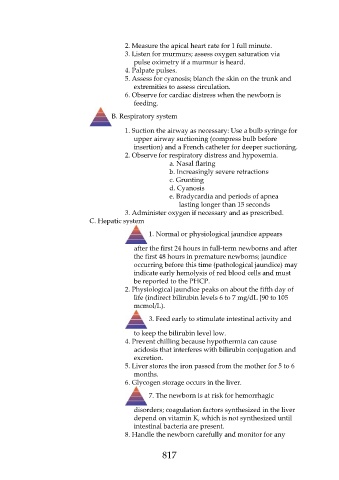Page 817 - Saunders Comprehensive Review For NCLEX-RN
P. 817
2. Measure the apical heart rate for 1 full minute.
3. Listen for murmurs; assess oxygen saturation via
pulse oximetry if a murmur is heard.
4. Palpate pulses.
5. Assess for cyanosis; blanch the skin on the trunk and
extremities to assess circulation.
6. Observe for cardiac distress when the newborn is
feeding.
B. Respiratory system
1. Suction the airway as necessary: Use a bulb syringe for
upper airway suctioning (compress bulb before
insertion) and a French catheter for deeper suctioning.
2. Observe for respiratory distress and hypoxemia.
a. Nasal flaring
b. Increasingly severe retractions
c. Grunting
d. Cyanosis
e. Bradycardia and periods of apnea
lasting longer than 15 seconds
3. Administer oxygen if necessary and as prescribed.
C. Hepatic system
1. Normal or physiological jaundice appears
after the first 24 hours in full-term newborns and after
the first 48 hours in premature newborns; jaundice
occurring before this time (pathological jaundice) may
indicate early hemolysis of red blood cells and must
be reported to the PHCP.
2. Physiological jaundice peaks on about the fifth day of
life (indirect bilirubin levels 6 to 7 mg/dL [90 to 105
mcmol/L).
3. Feed early to stimulate intestinal activity and
to keep the bilirubin level low.
4. Prevent chilling because hypothermia can cause
acidosis that interferes with bilirubin conjugation and
excretion.
5. Liver stores the iron passed from the mother for 5 to 6
months.
6. Glycogen storage occurs in the liver.
7. The newborn is at risk for hemorrhagic
disorders; coagulation factors synthesized in the liver
depend on vitamin K, which is not synthesized until
intestinal bacteria are present.
8. Handle the newborn carefully and monitor for any
817

